
In 2018 Australia imported goods from China to the value of US$57.7 billion or A$77 billion with an average exchange rate of .75 That is nearly $6.5 billion a month, every month.
It came as a shock to almost everyone to learn recently that we import over 90% of the medicines we use and most of them come from China and America. If China doesn’t make the final product they do make many of the ingredients. This alarming fact may never have come to light without the outbreak of the COVID19 corona virus. If China stopped supplying us and or America with medicines, what would we do?
We no longer live in a world of ‘It can’t happen here’ Because we know it can. We rely on China for so much; over US$13 billion in electrical goods — that must be most of our TVs and phones surely? Is this a danger to our independence and sovereignty?
It would seem that the President of the United States didn’t realise that America is in the same boat as us when it comes to China and medicines. The last American factory to make penicillin closed about ten years ago and these days, like Australia, America relies heavily on China for antibiotics as well as a range other medicines and so much more like the personal protective equipment (PPE) the cost of which coming out of China has skyrocketed.
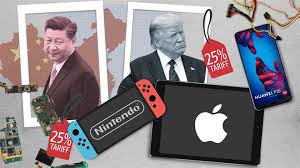
During the Trump presidency the relationship between China and America has been tenuous to say the least. The balance of trade between the two is heavily weighted in favour of China and Trump realised early in his term that America had exported technology and jobs to China and this had cost American dearly.
I wonder if President Trump realised when he started to place tariffs on Chinese imports into America, that China, if they had wanted to, had him over a barrel when it came to the maintenance of the health system in his country? I wonder if anyone, apart from the pharmaceutical companies and the PPE manufacturers realised what a precarious position they had placed America in, all in the name of their profit?
The effect of the Trump strategy to reinvigorate manufacturing in America and get jobs back from China is well known — praised by some and hated by others.
Prior to this current pandemic crisis unemployment in America at the end of 2019, including that of Blacks and Hispanics, was at an all-time low of 3.5%. Contrary to what was happening in most other advanced economies in the world including Australia, the average wage in America was also rising.
In Australia the no matter where one looks the influence of China and Chinese products is chillingly apparent. Everything from the shelves of our hardware giant Bunnings, to almost ever item of clothing available in it seems every clothing shop. The growth and so our reliance on China is both staggering and concerning:
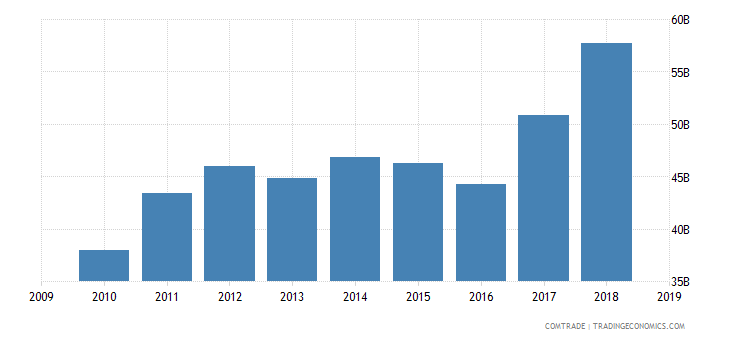
If we use an average exchange rate of .75 for the period 2010 to2018 our imports from China in Australian dollars have grown from $49 billion in 2010 to $77 billion in 2018 an increase of 53%.
So what are the big items we imported from China in 2018? Remember all in US$:
Table 1.
| Electrical, electronic equipment | $13.03B | 2018 |
| Machinery, nuclear reactors, boilers | $10.58B | 2018 |
| Furniture, lighting signs, prefabricated buildings | $3.47B | 2018 |
| Articles of iron or steel | $2.62B | 2018 |
| Plastics | $2.33B | 2018 |
| Articles of apparel, not knit or crocheted | $2.27B | 2018 |
| Articles of apparel, knit or crocheted | $2.15B | 2018 |
| Toys, games, sports requisites | $1.95B | 2018 |
| Mineral fuels, oils, distillation products | $1.82B | 2018 |
| Vehicles other than railway, tramway | $1.27B | 2018 |
| Aluminum | $1.15B | 2018 |
| Other made textile articles, sets, worn clothing | $986.80M | 2018 |
Between 2013 and 2019 Australia spent $44 billion (US$33 billion) on renewable power generation. All but $428 million of that amount was spent on wind and solar. More than 60% of the worlds solar panels and 37% of the wind turbines are made in China.
Are we Now in the Grip of China?

The incontrovertible fact is that if Australia slipped quietly into the ocean and stopped emitting carbon dioxide tomorrow, the climate of the world would not change by one iota.
China and India are increasing their emissions as if there is no tomorrow. There are some very clever people in China and India. I have seen no sign that they are committed to the extinction of the world as we and they know it. The contrary is the case.
China continues to be the worlds biggest emitter of the so-called contaminant carbon dioxide, and at one and the same time our reliance and probably the worlds reliance on China and Chinese products grows almost exponentially. Has China now got Australia into a position where we cannot manage, cannot live in the manner to which we have become accustomed without China?
Without even studying the eleven groups of products (Table 1) that we import into Australia every year, you don’t need to be a Rhodes Scholar to deduce that most of them are produced by heavy industry in China. Those that aren’t are labour intensive industries involved in the manufacture of clothing and apparel.
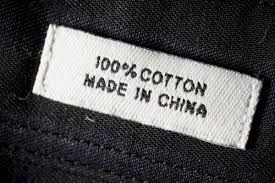 If you go to the rest of the list it becomes more apparent that as many have written before me, that we don’t make ‘stuff’ anymore in Australia. We have lost our manufacturing base. In the sixties I remember my mother vehemently declaring that she would only buy Australian Made (or British because they were the same to her) when ever she could, especially when it came to clothing and electrical goods. There was little she couldn’t buy that wasn’t Australian made
If you go to the rest of the list it becomes more apparent that as many have written before me, that we don’t make ‘stuff’ anymore in Australia. We have lost our manufacturing base. In the sixties I remember my mother vehemently declaring that she would only buy Australian Made (or British because they were the same to her) when ever she could, especially when it came to clothing and electrical goods. There was little she couldn’t buy that wasn’t Australian made
In those days it was ‘Made in Japan’ that my mother was wary of, not because as far as I know, she had any more enmity towards the Japanese than any of her generation, it was just that she was proud of ‘home made’ brands.
 We have exported many industries, together with the jobs from management to workshop floor because we decided, by we, I mean those who make these decisions from state and federal governments through to the Boards on Collins Street or St George’s Terrace, to those individual business people who made the decision to move Australia’s manufacturing base off shore to maximise their profit. The price Australia has paid has been the loss of not only Australian jobs but Australian skills.
We have exported many industries, together with the jobs from management to workshop floor because we decided, by we, I mean those who make these decisions from state and federal governments through to the Boards on Collins Street or St George’s Terrace, to those individual business people who made the decision to move Australia’s manufacturing base off shore to maximise their profit. The price Australia has paid has been the loss of not only Australian jobs but Australian skills.
Why are governments mentioned? It is governments state and federal of both political persuasions who have sat on their hands and watched this country export technology and jobs without raising an eyebrow never mind a hand.
Australian governments of all political persuasions have believed in the ‘free market economy’ and a ‘level playing field’ introduced by Hawke and Keating, and have failed to realise that other countries and governments only believe in the ‘free market economy’ and a ‘level playing field’ when it suits them. Two glaring examples are the subsidies paid to the international motor industry and to agriculture which have been and are denied to Australian manufacturers and producers.
Manufactures only move to another country when they are offered a better deal. In Australia we now have the highest power prices in the world. We have some of the highest labour costs in the world together with generous leave and conditions.
I once tried to explain our policy of paying employees more when they go on holiday, my American colleagues thought I was talking about a deduction, when I told them it was a leave loading they laughed and shook their heads in disbelief. They rolled around laughing when I explained long service leave entitlements.
On the Sheep’s Back.
We have a history in Australia for avoiding the blatantly bloody obvious when it comes to making ‘things’.
This blindness or is it arrogance, stretches right back to when we became the producers of the best apparel wool in the world and sent the first bale to England in 1807. It went to William Thompson’s mill in Yorkshire and was made into a black suit. From humble beginning to a suit by Ermenegildo Zegna of Italy, which today, two hundred and thirteen years later, will set you back at least three thousand dollars for a couple of kilos of wool.
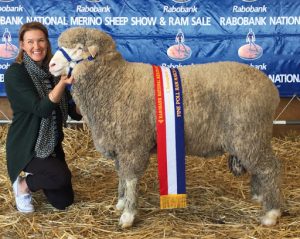 Merino wool is a fibre that gradually transformed the wool textile industry — from making coarse tweeds and serge to weaving cloth so fine, soft and warm that it became a fabric of quality and status and was in demand the world over.
Merino wool is a fibre that gradually transformed the wool textile industry — from making coarse tweeds and serge to weaving cloth so fine, soft and warm that it became a fabric of quality and status and was in demand the world over.
From the 1820s right through to the 1990s and beyond Australian wool producers saw no reason to value add to their raw wool and produce the best apparel fabric in the world. They were quite happy to put a dirty, smelly, greasy animal fibre into a bale and let the British and the Europeans transform into fabric for the raiments of the rich.
The Australian wool producers preferred instead to have their wool cheques docked with a levy that went to the International Wool Secretariat (IWS) who were charged with the marketing of wool around the world.
Their job was to talk to the wool industry from top maker to suit maker extolling the virtues of wool —not just Australian wool the best in the world, but any wool from wire like wool from the hairy Shetlands to Super Fine Merino from Australia and New Zealand.
In joining the IWS, Australian merino wool lost its identity, it failed to brand itself as the best wool in the world, unique and distinctive. Don’t think for a moment that I write with hindsight on this matter, because I don’t.

I never did understand the IWS and the millions of dollars that went into their coffers and then just went, disappeared, as the price of wool went up and down and down and up, seemingly for no reason and in spite of the effort, or so they told us, of the IWS.
The only thing that didn’t change for the better was the levy — it always went up!
I said all those years ago that the IWS was useless, and I still haven’t got over it.
Suddenly The World Changed.
Then in the 1960s and 70s two major events took place in Australia. In Western Australia iron ore was discovered in the Pilbarra, thanks to Gina Rinehart’s father Lang Hancock.
Reports at the time were that there was enough high grade iron ore in the Pilbarra to supply the world’s needs. It was claimed at the time and it has now been shown to be true, that Pilbara iron ore is indeed the best in the world for producing high grade steels.
In Queensland they were discovering millions of tonnes of high quality coal and the Premier was Joh Bjelke Peterson, like Hancock, was keen to exploit the possibilities of this national wealth and see Australia grow into a mature manufacturing nation and at the same time capitalising on its valuable mineral assets.
In 1979 Hancock and Peterson hatched a plan which in those days was laughed at by protectionist conservative Australia.
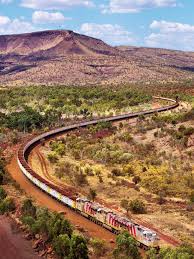 This pair of bold visionaries wanted to build a rail line some 3,500 km across the continent from the Pilbarra to Townsville via Alice Springs.
This pair of bold visionaries wanted to build a rail line some 3,500 km across the continent from the Pilbarra to Townsville via Alice Springs.
Coal, would be transported by rail from Queensland to the Pilbarra, where there would be one or two state-of-the-art furnaces and steel mills and a new deep port for the biggest ships to take the steel around the world.
Iron ore would be railed back to the coal in Queensland where another furnace and steel mill would be built at the port of Townsville.
No longer they claimed would Australia need to import steel to build its future —instead Australia would supply the world with the best steel in the world and at the same time grow with a world beating industry.
They failed, I understand, because the country and the banks did not support them.
Australia is now an importer of steel from China— in 2018 China produced 50% of the world’s steel.
Australia is now the biggest exporter of iron ore and coal in the world. Most of it goes to China, Korea and Japan, three of the biggest steel makers in the world.
Australians are paid in jobs, which are few in real terms and in royalties which are small, when they could have had the real prize — a steel industry to fund growth for as long as the world wants steel.
Did we Wimp on the cost of a Rail Line to Change the Country or was the Project just too big for Australia?
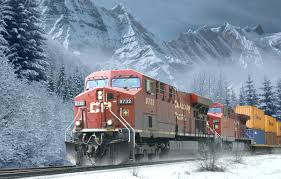
I am currently researching why the proposed train link from the Pilbara to Townsville didn’t happen and whether there is an opportunity for it to happen now some forty years after the original proposal.
It is obvious that a rail track could be laid across Australia, a survey carried out by two fellows in a SWB Landrover in the 70’s showed there were no problems with the route that could not be easily overcome. Of great interest was the proposition at the time for the rail to go through Alice Springs. What sort of a difference would that have made to the pastoral industry in those days? What a difference it would make now?
There are so many precedents around the world for trans-continental rail and some of them were constructed long before 1979.
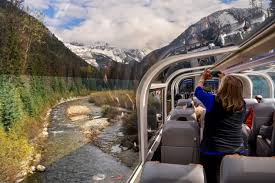
There is a train that in 86 hours crosses Canada from Toronto to Vancouver. It carries people and freight a distance of 3500 km. It crosses the Rockies and the fare costs A$500 per person.
There is a train that crosses America from Chicago to Seattle, a distance of 2800 km, it carries freight and people. The rail fare is A$270 per person and the journey last for about 50 hours.
The Indian – Pacific that crosses Australia from Perth to Sydney a distance of 4300 km. It carries people and freight. The rail fare is about A$5400. True! If that is what people cost I wonder what the freight costs are?
Do we Baulk at the Strategy High Fence?
The moral to this story for me is that over the last fifty to one hundred years or so, here in Australia we have avoided planning for our long term future.We have opted for short-term tactics rather than a long-term strategies. We have become or have always been complacent. A good example is our current oil stocks. We have less than a month’s suplly of petrol and diesel in the country and we live on an island.
At heart we are either aristocrats and believe ‘industry’ to be beneath us, or we are miners, and not interested in dirty industry that might be involved in value adding to raw materials like wool and iron ore and turning them into products we can export. Leave the ‘dirty’ industries to someone else —is that how we think?
Do we have at the heart of the Australian mindset a philosophy of maximum profit for minimal involvement, live life one-day-at-a-time, a ‘wham bam thank you Maam’ attitude? Too many beaches and barbecues and days in the sun? Too many long weekends and summers that never end? Has life just become too easy in Australia?
I remember taking an American business visitor from Detroit for breakfast down to Cottesloe Beach in Perth, Western Australia. We sat outside in the morning sun and he looked at the people and the beach and the surf and my friend said he couldn’t live in Cottesloe because he wouldn’t get anything done. He said it reminded him of California and all the beautiful people. He said the climate in Detroit was conducive to work.
I have often wondered if he was right?
Urban Sprawl Drives the Australian Economy.
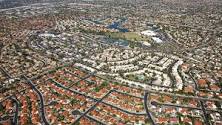 Over the last fifty years or so the population of Australia has doubled. Each and every year about 300,000 people have arrived on our shores.
Over the last fifty years or so the population of Australia has doubled. Each and every year about 300,000 people have arrived on our shores.
With an average of 3 people per house, that means we have built 100,000 houses every year for fifty years. That means we have built the equivalent to a new city somewhere between the size of a Geelong or Woolongong or the size of Canberra, every year for the last fifty years. A new Canberra every year, that is amazing.
We have provided those new cities with all the utilities, gas, water, power, sewage as well as roads, schools, hospitals. sports facilities and so on.
Two incomes are often needed to pay for a house these days so there has been a need to find employment for many of these people. Our national growth over the last fifty years has been driven by migration.
As we crawl out of these troubled times we will probably blame our politicians for our high levels of unemployment and underemployment, even though they told us it was coming. Legions of experts with the power of hindsight will point to what should and should not have been done.
For fifty years as we have watched our population and the economy grow, we have silently been exporting manufacturing jobs and skills, mainly to China.
The serious question we must now ask is what will happen to the Australian economy if migration slows or stops after this covid19 pandemic?
For the last fifty years our economy has been driven by migration — the irony is that Australia is now seeking only skilled migrants.

Hi Roger, Hope your health has improved since I met you. My son is paying $ 12.50 per sheep to get them shorn this year. There may be a trend to breed the wool-less sheep if costs keep rising. The problem with that is that China may not get enough wool to fill their mills orders and may change to cotton or synthetics. Cropping yields were good this year at Darkan. The state Labor government seems to be doing everything to reduce the rural population , re coal, live sheep, local timber and rural representation. The rural roads are a mess, especially where these triple trailers are being used. The Darkan – Arthur River road is a mess and will become quite dangerous when it rains.
regards Trevor